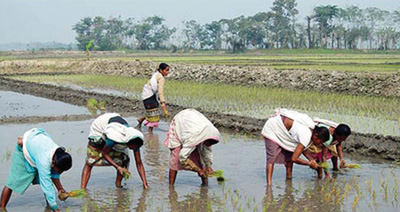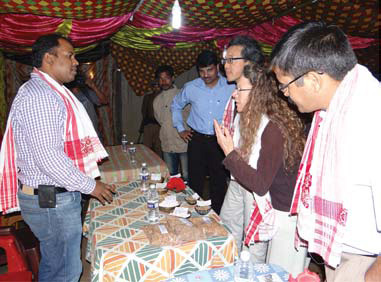A Rice in Production
Assam’s Indigenous Rice Finds Place In The World Market
 Bao-dhaan, an organic and indigenous rice paddy in Assam, popularly known as red-rice has found its space in the world’s rice market thanks to the initiatives of district administration of Dhemaji - a severe flood - prone district in Upper Assam, State Agriculture Department and Agricultural and Processed Food Products Export Development Authority (APEDA), Assam to establish business tie - up with Lotus Foods, a corporate body of international repute known for procurement of rice based in the United States.
Bao-dhaan, an organic and indigenous rice paddy in Assam, popularly known as red-rice has found its space in the world’s rice market thanks to the initiatives of district administration of Dhemaji - a severe flood - prone district in Upper Assam, State Agriculture Department and Agricultural and Processed Food Products Export Development Authority (APEDA), Assam to establish business tie - up with Lotus Foods, a corporate body of international repute known for procurement of rice based in the United States.
Over 300 MT of the indigenous rice paddy, grown abundant throughout the State in deep - water will soon be sent to the US benefiting hundreds of poor and marginal farmers of the State. The State Agriculture Department has directed the Assam State Agriculture Marketing Board to procure the rice directly from the farmers and subsequently sell it to Nature Bio Foods Ltd. based in Haryana, which is the partner of Lotus Foods in India.
“The process of procurement of bao-dhaan from the district has started last year, when a team of experts of the US based company visited the district. Last year the company procured nearly 32 MTs of the red - rice as the first consignment. This year, they have increased the volume to a huge 300MT,” says MS Manivannan, Deputy Commissioner, Dhemaji district, who is an instrumental figure behind the entire process.
The Deputy Commissioner says that a shortage of over 100 MTs of rice in the district has made the district administration to procure the rest from Majuli island of Jorhat district.
Assam is enriched with a number of indigenous rice varieties rich in high nutrient value. The bao-dhaan is an indigenous rich paddy, traditionally known for the iron, protein and anti-oxidant elements it contains, due to which it has gained popularity in the international market. The State is abundant with a number of varieties of bao-dhaan including kekuwa, amona, rangoli, etc. This deep - water rice paddy plays an important role in traditional Assamese cuisine. However, of late, in sharp contrast to an increasing demand of bao-dhaan in the international market, local people have shown apathy in consuming this rice in comparison to other varieties of rice available in the State.
 “We are so happy that the district administration of Dhemaji has come forward to procure this huge amount of bao-dhaan from us. Majuli has a rich tradition of cultivating this particular rice paddy with nearly 1000 hectares of land under this cultivation. Production of this rice paddy is around 2.5 tonnes per hectare,” says Badrinath Sonar, Sub-divisional Officer, Agriculture, Majuli.
“We are so happy that the district administration of Dhemaji has come forward to procure this huge amount of bao-dhaan from us. Majuli has a rich tradition of cultivating this particular rice paddy with nearly 1000 hectares of land under this cultivation. Production of this rice paddy is around 2.5 tonnes per hectare,” says Badrinath Sonar, Sub-divisional Officer, Agriculture, Majuli.
One of the important features of this particular rice variety is that it is naturally water resistant, and grows high with the increase of water levels during the monsoons. Unlike many other varieties of rice, bao-dhaan does not require much technical expertise and grows immediately after sowing after the cultivation area is prepared. Bao-dhaan is easily grown in all high flood prone areas of the State. It is purely an organic food. To encourage the cultivators into producing more, the export giant from the US is also ready to pay the cultivators a price much higher than the one they are getting in the domestic market.
“As of now the market price of per kg red - rice is only Rs.9.50. The opening up of export tie - ups has enabled the cultivators to earn at least Rs.15/ per kg.” says Bidyut Baruah, Assistant General Manager, APEDA, the facilitating agency of the export deal.
He also says that immediately after a visit to Dhemaji district during November, 2012 which was organised by APEDA, the US delegation of buyers met the State Agriculture Minister Nilamoni Sen Deka, expressing their keen interest in importing the red - rice which is having special nutritional and medicinal value. Contrary to the usual tendency of local people to go for taste while consuming this particular rice variety, the main thrust remains on the nutritional value it bears in the international market, he adds.
The AGM has also stressed on building infrastructure for storage and quality control of this huge amount of rice in order to get a sustained export market. He has also stressed on the need for more efforts on research and development of these indigenous rice varieties of the State which are mostly organic in nature. The importance of research and development is important, as in comparison to other high - yielding varieties of commercial rice paddy, bao-dhaan requires a longer period of over six months for the entire cultivation process. The seed - sowing season begins during April and the harvesting season lasts up to the end of October.
Till this tie-up, the only exporter of red - rice to US was Bhutan, which annually exports over nine containers of the rice - variety annually. One container bears nearly 20MTs, Baruah adds.
| Over 300 MT of the indigenous rice paddy,grown abundant throughout the State in deep - water will soon be sent to the US benefiting hundreds of poor and marginal farmers of the State. |
Baruah also says that with a high and growing demand for various colourful rice varieties in the international rice market, opportunities for marketing other varieties of indigenous rice paddy too, has increased by leaps and bounds. APEDA has been exploring possibilities of finding more international markets for the other rice varieties from the northeastern states including Manipur and Tripura.
In the meanwhile, the Assam State Agriculture Marketing Board is busy in preparing a memorandum of understanding with the Nature Bio Foods Ltd. Haryana for the purpose. The State Agriculture Department is hopeful of spreading cultivation of this rice paddy to other potential districts of the State too.
The agricultural sector supports over 75 per cent of the population in Assam directly and indirectly providing employment opportunities to around 53 per cent of the total workforce. According to provisional figures of 2010-11 Agriculture Census, 85 per cent of the farmer’s families in the State is small and marginal with an average operational holding of 1.10 hectares. In such a situation, procurement of indigenous rice varieties directly from farmers with an ensured market price much higher than what they can get in the domestic market is likely to improve the socio - economic condition of these poor farmers to a great extent.


